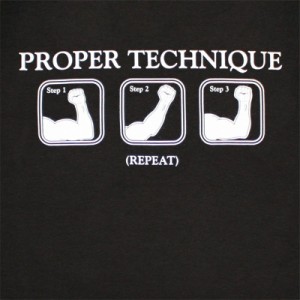Unconventional Exercises for Scapular Stability
I’ve been playing around with a few varied movements to try to get some clients with rotator cuff issues stronger, meaner and more pain-free beastly than ever, and I wanted to share some of them with you today.
First, a little background. I’ll admit to being one of those guys who thought scapular stability and rotator cuff training should consist of repetitive sets of elastic band external rotations followed with side lying dumbell external rotations and finished off with cable standing external rotations, which got all the benefit of Eli Manning raising his hand yesterday and saying “So, I just won a second Superbowl, do I get to make $19 million a year? Should I sit this one out too? No? Okay, just checking.”
As a result of my clients not getting any better from that kind of stuff, I started playing around with some other training methods, read some more, saw some cool stuff that made me change my whole thought process, and put it into action. The results were pretty cool, as the majority of my rotator cuff clients could say they felt a noticeable improvement in strength, mobility, and reduction in pain. Amazing how following a system that works actually produces the best benefits!!
One thing to consider with scapular stability is the name. “Stability” means that shit ain’t goin no where, so doing countless reps of a big range of motion aren’t really training the area for anything other than the ability to do countless reps. The goal should be to make the shoulder work to maintain position and to maintain it in different positions for as long as desired with as much weight as desired. I’ve had little old grandmothers doing some of these, as well as dudes hyped up on enough testosterone to make the fathers of highschool daughters get a little trigger happy.
One word of warning though. Everyone is different, and the client’s I’ve had go into these movements had to qualify to do them, not just walk through the door. They had to have enough stability and range of motion to do the movements and to get into the positions without pain. I’m not going to recommend someone give these a try if it means shoving a round peg into a square hole.
Some key components to consider before embarking on any of these exercises are the following:
1. They need a fair deal of thoracic extension and rotation mobility. How much do you have? Do you resemble Montgomery Burns? If so you should probably sit this one out, champ.
2. Is your shoulder currently sore? Go find someone who can tell you whether it’s a good idea to do these or not, and then follow their instructions
3. Do you have enough shoulder mobility to get your arms overhead? Can you make your torso rock-solid and strong? If no, work on these for a little before we get rolling.
Enough chatter, let’s get at ‘er!!!
Exercise #1:Dumbell Overhead Side Rolls
This is a precursor to a turkish getup, and puts a lot of demand on the shoulder to maintain a specific position and centration within the shoulder joint. Moving or swaying outside of this centered position could result in unsightly slings and casts.
Technical Observations
1. Use a challenging weight for this one. You can see that I’m rocking a 70 pound dumbell, which is a good challenge for me. As my right shoulder doesn’t have any stability issues, I can manage it pretty comfortably. If you feel comfortable up to a 5 pounder, more power to you, but make sure it’s challenging enough or you won’t get anywhere as the shoulder isn’t what is doing the movement here. It’s merely holding the weight up while rotating through a transverse plane of motion.
2. The movement is driven by the glutes and hamstrings of the leg on the same side of the dumbell, and the core is kept tense to make the transfer of force from lower to upper occur as seamlessly as possible.
3. Fist pumping is not recommended with the dumbell during this exercise.
Exercise #2: Overhead Side Bends
Similar in nature to the side rolls, this one keeps the weight and shoulder in a fairly stationary position while the body rotates under it, this time making the humerus go through a frontal plane of motion. This one can be tricky especially if the person has limited hip mobility.
Technical Observations:
1. Take a wider than shoulder width stance and point your lead leg out away from you (in this case my left foot) so that you can bend sideways more effectively.
2. Keep the weight vertical the entire time and centered overtop of your shoulder.
3. Apparently I have a 7 foot wingspan.
Exercise #3: Waiters Walk
This loaded carry variation is both simple to execute and ridiculously difficult to complete effectively.
Technical Observations:
1. Work on getting the arm overhead as straight as possible and vertical over the shoulder. I use the cue “get your biceps into your ears,” as long as the client keeps their head on vertically and doesn’t try to lean their ear to their arm, we’re cool.
2. Stand as tall as possible, as even a slight hunch can limit scapular retraction and depression, which will in turn increase the contact pressure between the acromion process and the supraspinatus tendon, a likely culprit in a lot of shoulder problems.
3. The low arm should have a heavy-ass weight, one that throws you slightly off balance and threatens to leave a portion of your palm embedded into the handle for all eternity.
Exercise #4: T-Pushups
This pushup variation requires a lot from the shoulders at the top of the movement as the weight is stacked through the joint with a rotational force having to be countered through the transverse plane.
Technical Observations:
1. My triceps scare small children.
2. Keep the core tense throughout, and rotate the body as one fixed unit. This makes the shoulder do the work for rotation and stabilization instead of the spine.
3. Keep the scapula plastered to your ribs, no trying to imitate a row during your descent and ascent, and no poking your head to the floor like a turtle sticking his head out of his shell.
4. Fist pumps are recommended on every rep of this exercise, though.
Exercise #5: TRX Isometric Row Hamstring Curls
Why would you want to just work your hamstrings when you could call the lats into the party as well?? This little doozy works pretty much everything you can’t see in the mirror without turning around, right from your calves through the hamstrings, glutes, lats, spinal erectors, rhomboids, delts, and probably a few spots I can’t even think of.
Technical Observations:
1. Keep the elbows tight to the body, and the hands pulled right against the ribs the entire time.
2. Squeeze those glutes like you’re trying to strangle your underwear. If you don’t wear underwear to the gym, for the love of god please use some sani-wipes after you use the equipment.
3. Go slow, as a fast movement will only work on your ability to swing around like a jackass, and the momentum will prevent you from getting any feeling of hot buttered death coming from your hamstrings.
Exercise #6: Half Kneeling Overhead Stabilization
This one looks all simple and cuddly, but if you load it with a tense enough band, or even with some heavier than tolerable dumbells, you can get a pretty fantastic workout. By holding the weight overhead for an extended period of time, you have to work the scapular stabilizers in an overhead position, as well as the core musculature to resist deformation against the axial compression. It’s pretty boss.
Technical Observations:
1. Get rock solid through the core, and make sure you’re not sitting with an anterior tilt in your pelvis. You should feel strong and tense through the core, with equal pressure everywhere, not through your lower back.
2. The arms should be perfectly straight, not even a slight bend in the elbows is allowed. Also make sure you’re not rocking the no-neck look and keep your shoulder blades our f your ears. Fashion designers around the world won’t be flocking to produce runway lines featuring the “ears on shoulders” look, so don’t perpetuate it in the gym, si vous plait.
3. Fist pumping here is likely to blow out your O-ring, so skip it until the cooldown champ.There you have it folks, six exercises to give you some fantastic variations for training scapular stability. Train these bad boys up so that when the next season of Jersey Shore hits you won’t wind up with burning numbness radiating down your arm Friday mornings from all the fist pumping Thursday evenings.


16 Responses to Unconventional Exercises for Scapular Stability